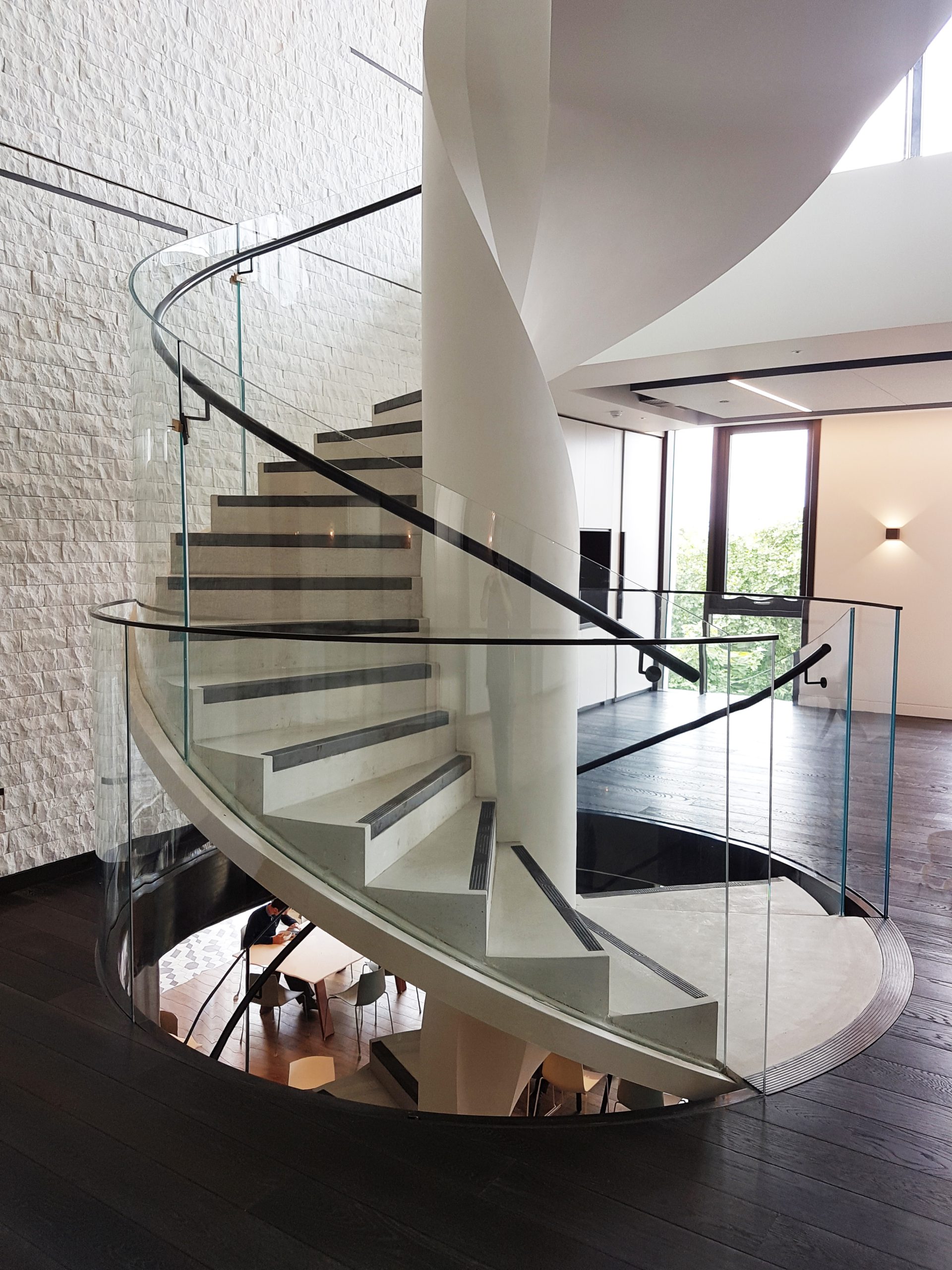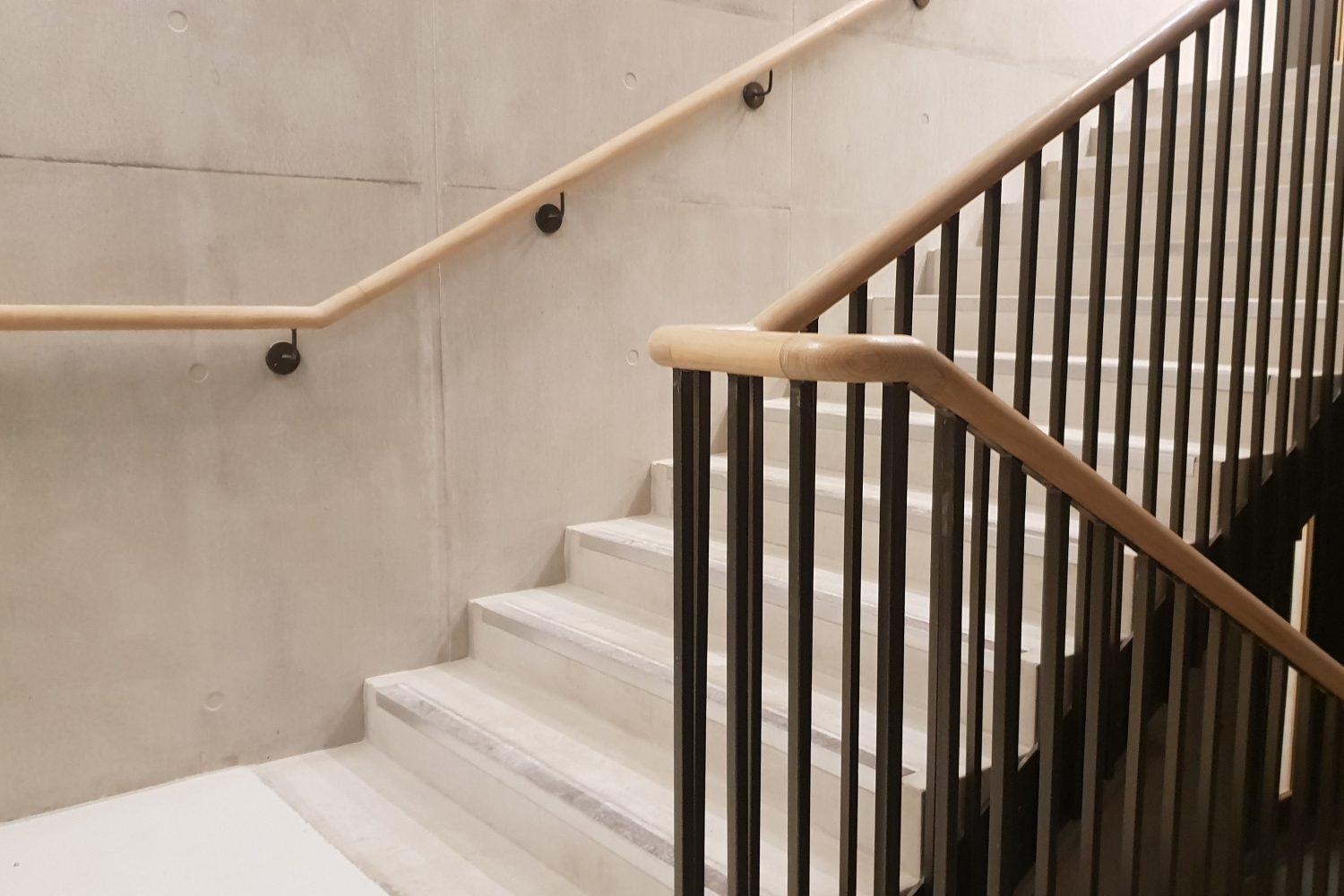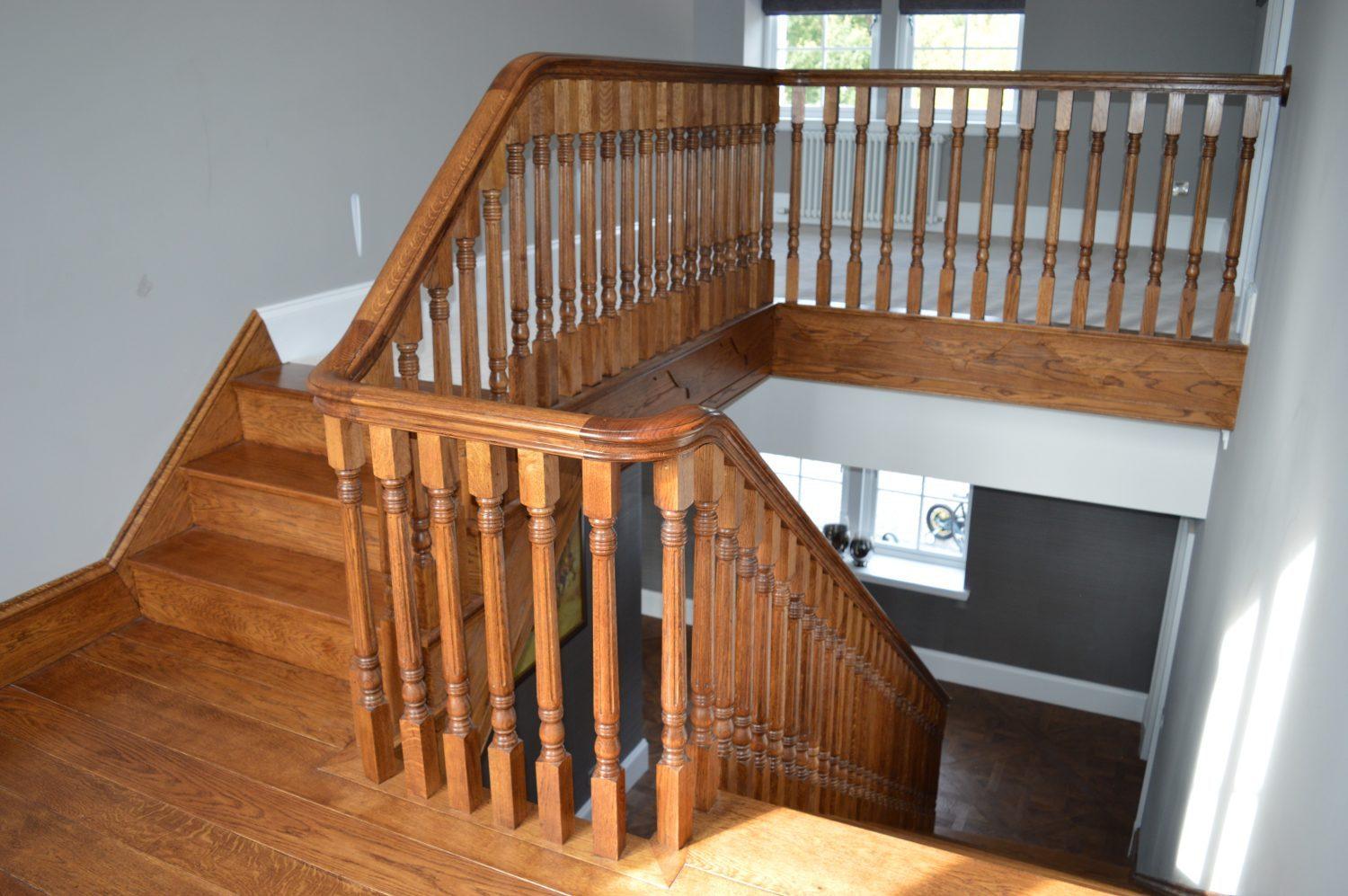What are the different types of handrails for stairs?
Choosing the right stair handrail can be harder than it looks. It needs to be safe, durable, and visually consistent with the rest of the space. And with so many designs, materials and extra features to choose from, designing a bespoke handrail for your project may be more difficult than you might think – where do you start? What material, and what style do you choose?
This guide breaks down the different types of stair handrails, so you can select or recommend the right option with confidence.
What can handrails be made from?
Before you can decide between the various types of handrails, the first thing to decide is the material you want to work with. Your chosen handrail material will have a huge impact on both the functionality and aesthetic appeal of the staircase, affecting the entire space as a whole.
Wooden handrails

Wooden handrails are one of the most traditional and popular types of handrail. They’re most frequently found in residential properties because wood feels comfortable and warm to the touch compared to materials like metal. The upside of wood is that it can be carved, sanded, stained, varnished, painted and repainted to fit a client’s exact vision for the space in a way that metal can’t.
Hand carving is still frequently practised, but specialised projects can achieve handrail shapes that simply aren’t possible with other materials. For example, 5-axis CNC machining is an incredible process that’s used to craft totally unique styles. These machines use a tool that moves in five different directions, allowing them to modify the wooden rail from any direction or position.
Compared to glass and metal, wooden handrails tend to be more affordable (with the exception of more expensive hardwoods). Oak, walnut, ash and pine are the most common woods used. Softwoods are often used for standard stairs sold by large retailers, whereas specialist handrail designers like Handrail Creations use premium hardwoods for their superior appearance and durability.
The downside of wood is that it can be less durable than other handrail materials like metal and glass, even with tough hardwood varieties like oak, walnut and sapele, although regular cleaning and varnishing helps.
Learn more: Wooden vs. metal handrail design
Metal handrails
Metal handrails are commonly found in commercial spaces, and they’re also among the best types of handrails for outdoor steps. However, they can also be used in modern homes, pairing well with the sleek, clean, minimalistic style of metal railings. While metal railings typically aren’t found in more traditional homes, they’re a good choice for projects requiring a more contemporary or simple design.
The benefit of metal: it’s easier to clean than wood thanks to its wipeable surface, making it useful for gyms, pools and kitchens that need to comply with strict hygiene standards. Metal is also extremely long-lasting, so it’s a good choice for areas where handrails will experience heavy use or be exposed to the elements. Metal doesn’t rot, split, or bleach outdoors, although it can rust.
There are three main types of metal handrails: stainless steel, wrought-iron and brass.
Stainless steel
Stainless steel is popular thanks to its extreme strength and durability, making it a great choice for public projects with safety and cost-effectiveness concerns. It has a chromium-rich oxide film on its surface to resist corrosion, so it’s very easy to maintain in pristine condition. Apart from regular cleaning, stainless steel won’t need any treatments like wood does.
Wrought-iron
Wrought-iron handrails look more traditional due to their popularity in the 1800s, before steel became more commonly used for metal railings. They are frequently found in gardens and public outdoor spaces, but they can also be used domestically if they fit the style. Iron is famously malleable, so iron railings with ornate decorative effects like scrolls and leaves are common, although they can have a simpler, more angular appearance for an industrial style.
Brass
Brass is best known for its warm yellow, red, brown and gold tones, lending an air of warmth and sophistication to any space. Like other metals, brass is very easy to wipe clean, and since it includes copper, it also has natural anti-microbial properties.
The issue with brass is that it isn’t as durable as other metals. Brass handrails need to be regularly cleaned and maintained to prevent tarnishing, and they are also less suitable for outdoor use as they can discolour.
Leather-wrapped handrails
Leather-wrapped handrails are available in a wide range of colours and finishes, allowing you to design a handrail that either perfectly complements an existing colour scheme or acts as an exciting pop of colour or interesting texture. Plus, by wrapping the wood or metal underneath, the leather will make the handrail warmer, more comfortable, and more luxurious to the touch. This is an increasingly popular stylistic choice for high-value homes, hotels and restaurants.
Glass handrails and balustrades

Increasingly popular in modern homes and commercial buildings, glass improves the flow of light around a space, making it seem more open. Glass handrails and balustrades are surprisingly sturdy and durable, as they’re made from toughened glass that’s heat-treated to improve its strength. And if this toughened glass does break, it’s designed to shatter into small, blunt pieces rather than dangerous shards.
Glass bannisters tend to have a wooden or metal handrail on top to make them easier to hold. Glass balustrade panels can be completely clear, frosted, tinted or semi-transparent, but with clear panels, they can end up covered in marks and fingerprints. They benefit from regular cleaning.
Another key downside of glass balustrades is that they are difficult and time-consuming to manufacture and install. Even toughened glass panels can be very brittle during installation. It’s possible to manufacture curved glass if this is needed for your project, but since glass can only curve to a certain radius without breaking, curved panels can’t be made to tight tolerances, which is problematic if you’re working with strict design parameters. Plus, curved glass panels can be very expensive too.
Mounting types
Another way you can classify the different handrail types is by the way they’re mounted.
Integrated handrails
Integrated handrails are those that are installed on top of a balustrade. They are required for open staircases (i.e. without a wall on both sides), as the railing is needed to prevent people from falling off the stairs. Integrated handrails can either be grooved or ungrooved.
Grooved handrails

As the name suggests, grooved handrails feature a groove on the bottom that’s designed to fit the balusters neatly inside for a fully integrated installation. This works for both vertical posts and panels; for example, glass handrails will feature a deep channel along their entire length to fit the glass balustrade panels inside. The grooved handrail must be customised to the exact size of the balusters, so that they fit together snugly.
Ungrooved handrails
Ungrooved handrails are fitted to the balusters with brackets or clamps, rather than being fully integrated. Ungrooved handrails are better for glass or metal railings, and can be used for wall-mounting too.
Wall-mounted handrails
For enclosed staircases that don’t have space for a full bannister, wall-mounted handrails are perfect for conserving space, whilst also providing adequate safety and comfort. These handrails are mounted directly onto the enclosing wall at arm height, either attaching flush to the wall or with separate fixtures.
Common handrail profiles
Last but not least is the profile of the handrail – its shape.
Mopstick handrails

The wall-mounted mopstick handrail is the classic cylindrical shape with a flattened base, and is one of the most common types in the UK.
While the mopstick handrail can be any material, the handrail brackets that attach it to the wall tend to be made of metal, which makes them particularly safe and durable. Due to this focus on safety, commercial projects require a mopstick handrail section to comply with UK building regulations.
You can also find fully cylindrical handrails, but these are more common with metal handrails.
Pig’s ear handrails
These wall-mounted handrails are fixed directly to the wall with screws and feature a curved shape that looks like a pig’s ear from the side, hence the name. Since they sit so close to the wall, they’re an excellent choice for very narrow staircases, and they can also be more cost-effective since brackets aren’t needed.
Wood is commonly used for pig’s ear handrails because it can be easily carved and sanded down to the desired shape. Plus, since wood is more comfortable and warm to the touch, this makes them even more sleek and easy to grip.
Square handrails

A little less common, squared or blocky handrails are another handrail design choice. A chunky, square handrail is a strong rustic design – particularly in wood – for domestic properties. However, with other materials or a glass panel balustrade, this angular design can look modern and industrial.
Here at Handrail Creations, we use state-of-the-art 3D surveying equipment to measure the exact dimensions of the staircase, allowing us to create grooved handrails with full confidence that they will fit first time.
Best of all? Bespoke handrails!
For unique projects featuring unconventional spaces or very specific aesthetic requirements, choose a fully bespoke handrail. Going bespoke means the perfect piece can be created for the project – especially if you’re working with spiral staircases, highly artistic custom staircase designs, or a very particular client.
With a bespoke handrail, you can choose the exact type of handrail you want: an elaborately ornate style or something cutting-edge and modern, plus all the finishing touches like unique, custom-made end caps or wall patrices.
Looking for a lovingly crafted, bespoke wooden handrail? Here at Handrail Creations, we design, manufacture and install wooden handrails to suit all kinds of residential and commercial projects, working with our clients from inception to completion to bring their exact vision to life. Get in touch today for a consultation, or visit our website for expert advice on your upcoming project.




Trackbacks & Pingbacks
[…] with so many varieties available, how do you choose the right […]
[…] this blog post, we’ll explore a variety of different balustrade and handrail designs for traditional, modern, and transitional residential hallways. From classic wooden finishes and […]
Leave a Reply
Want to join the discussion?Feel free to contribute!